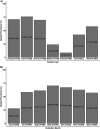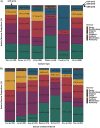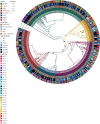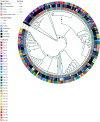A Longitudinal Study on the Dynamics of Salmonella enterica Prevalence and Serovar Composition in Beef Cattle Feces and Lymph Nodes and Potential Contributing Sources from the Feedlot Environment
- PMID: 37022263
- PMCID: PMC10132121
- DOI: 10.1128/aem.00033-23
A Longitudinal Study on the Dynamics of Salmonella enterica Prevalence and Serovar Composition in Beef Cattle Feces and Lymph Nodes and Potential Contributing Sources from the Feedlot Environment
Abstract
Salmonella can persist in the feedlot pen environment, acting as a source of transmission among beef cattle. Concurrently, cattle that are colonized with Salmonella can perpetuate contamination of the pen environment through fecal shedding. To study these cyclical dynamics, pen environment and bovine samples were collected for a 7-month longitudinal comparison of Salmonella prevalence, serovar, and antimicrobial resistance profiles. These samples included composite environment, water, and feed from the feedlot pens (n = 30) and cattle (n = 282) feces and subiliac lymph nodes. Salmonella prevalence across all sample types was 57.7%, with the highest prevalence in the pen environment (76.0%) and feces (70.9%). Salmonella was identified in 42.3% of the subiliac lymph nodes. Based on a multilevel mixed-effects logistic regression model, Salmonella prevalence varied significantly (P < 0.05) by collection month for most sample types. Eight Salmonella serovars were identified, and most isolates were pansusceptible, except for a point mutation in the parC gene, associated with fluoroquinolone resistance. There was a proportional difference in serovars Montevideo, Anatum, and Lubbock comparing the environment (37.2, 15.9, and 11.0%, respectively), fecal (27.5, 22.2, and 14.6%, respectively), and lymph node (15.6, 30.2, and 17.7%, respectively) samples. This suggests that the ability of Salmonella to migrate from the pen environment to the cattle host-or vice versa-is serovar specific. The presence of certain serovars also varied by season. Our results provide evidence that Salmonella serovar dynamics differ when comparing environment and host; therefore, developing serovar-specific preharvest environmental Salmonella mitigation strategies should be considered. IMPORTANCE Salmonella contamination of beef products, specifically from the incorporation of bovine lymph nodes into ground beef, remains a food safety concern. Current postharvest Salmonella mitigation techniques do not address Salmonella bacteria that are harbored in the lymph nodes, nor is it well understood how Salmonella invades the lymph nodes. Alternatively, preharvest mitigation techniques that can be applied to the feedlot environment, such as moisture applications, probiotics, or bacteriophage, may reduce Salmonella before dissemination into cattle lymph nodes. However, previous research conducted in cattle feedlots includes study designs that are cross-sectional, are limited to point-in-time sampling, or are limited to sampling of the cattle host, making it difficult to assess the Salmonella interactions between environment and hosts. This longitudinal analysis of the cattle feedlot explores the Salmonella dynamics between the feedlot environment and beef cattle over time to determine the applicability of preharvest environmental treatments.
Keywords: Salmonella enterica; feedlot cattle; feedlot pen environment; subiliac lymph nodes.
Conflict of interest statement
The authors declare no conflict of interest.
Figures









Similar articles
-
Population Dynamics of Salmonella enterica within Beef Cattle Cohorts Followed from Single-Dose Metaphylactic Antibiotic Treatment until Slaughter.Appl Environ Microbiol. 2019 Nov 14;85(23):e01386-19. doi: 10.1128/AEM.01386-19. Print 2019 Dec 1. Appl Environ Microbiol. 2019. PMID: 31519659 Free PMC article.
-
High-Resolution Genomic Comparisons within Salmonella enterica Serotypes Derived from Beef Feedlot Cattle: Parsing the Roles of Cattle Source, Pen, Animal, Sample Type, and Production Period.Appl Environ Microbiol. 2021 May 26;87(12):e0048521. doi: 10.1128/AEM.00485-21. Epub 2021 May 26. Appl Environ Microbiol. 2021. PMID: 33863705 Free PMC article.
-
Cross-sectional study examining Salmonella enterica carriage in subiliac lymph nodes of cull and feedlot cattle at harvest.Foodborne Pathog Dis. 2013 Apr;10(4):368-74. doi: 10.1089/fpd.2012.1275. Foodborne Pathog Dis. 2013. PMID: 23566273 Free PMC article.
-
Disease Occurrence in- and the Transferal of Zoonotic Agents by North American Feedlot Cattle.Foods. 2023 Feb 20;12(4):904. doi: 10.3390/foods12040904. Foods. 2023. PMID: 36832978 Free PMC article. Review.
-
The welfare of ill and injured feedlot cattle: a review of the literature and implications for managing feedlot hospital and chronic pens.Front Vet Sci. 2024 May 9;11:1398116. doi: 10.3389/fvets.2024.1398116. eCollection 2024. Front Vet Sci. 2024. PMID: 38799724 Free PMC article. Review.
Cited by
-
Genomic Profiling of Antimicrobial Resistance Genes in Clinical Salmonella Isolates from Cattle in the Texas Panhandle, USA.Antibiotics (Basel). 2024 Sep 4;13(9):843. doi: 10.3390/antibiotics13090843. Antibiotics (Basel). 2024. PMID: 39335016 Free PMC article.
-
Detection of a hydrogen sulfide-negative Salmonella Typhimurium from cattle feces in a cross-sectional study of cow-calf herds in the Southeastern United States.Front Vet Sci. 2025 Jul 29;12:1619880. doi: 10.3389/fvets.2025.1619880. eCollection 2025. Front Vet Sci. 2025. PMID: 40800227 Free PMC article.
-
Long-term genomic surveillance reveals the circulation of clinically significant Salmonella in lymph nodes and beef trimmings from slaughter cattle from a Mexican feedlot.PLoS One. 2024 Oct 18;19(10):e0312275. doi: 10.1371/journal.pone.0312275. eCollection 2024. PLoS One. 2024. PMID: 39423186 Free PMC article.
-
Rare serovars of non-typhoidal Salmonella enterica isolated from humans, beef cattle and abattoir environments in Nigeria.PLoS One. 2024 Jan 22;19(1):e0296971. doi: 10.1371/journal.pone.0296971. eCollection 2024. PLoS One. 2024. PMID: 38252613 Free PMC article.
-
Multidrug Resistance and Virulence Traits of Salmonella enterica Isolated from Cattle: Genotypic and Phenotypic Insights.Antibiotics (Basel). 2025 Jul 8;14(7):689. doi: 10.3390/antibiotics14070689. Antibiotics (Basel). 2025. PMID: 40723992 Free PMC article.
References
-
- Centers for Disease Control and Prevention. 2019. Antibiotic resistance threats in the United States. Centers for Disease Control and Prevention, Atlanta, GA.
-
- Centers for Disease Control and Prevention. 2022. FoodNet FAST-Salmonella. Centers for Disease Control and Prevention, Atlanta, GA.
-
- Hanson D, Ison J, Malin K, Webb H. 2020. Salmonella white paper. Beef Industry Food Safety Council. https://www.bifsco.org/Media/BIFSCO/Docs/BIFSCo_SalmonellaWhitePaper_3-1....
-
- Le Minor L, Popoff M. 1987. Request for an opinion: designation of Salmonella enterica sp. nov., nom. rev., as the type and only species of the genus Salmonella. Int J Syst Evol Microbiol 37:465–468.
Publication types
MeSH terms
LinkOut - more resources
Full Text Sources

